Are you looking to play a game of tennis? You’ll need a racquet for that. What’s that? — you don’t have a tennis racquet? Well then, we happen to have just the guide for you.
If your goal is to become a renowned tennis master, there’s nothing stopping you from jumping to the top of the food chain by emulating Roger Federer’s exact racquet setup. However, we should remind you that skill in tennis depends much more on the player than the racquet.
That being said, choosing the right racquet is still an instrumental part of the game. In this article, we’ve compiled a list of the best tennis racquets for beginners, intermediate and advanced level players.
Contents
Features to Consider in Good Tennis Racquets
When choosing a tennis racquet, it’s important to keep a few key features in mind when shopping around.
Experience Level
If you’re a beginner, there’s nothing stopping you from picking up a top of the line, expert-level racquet to start learning the game with. In the same vein, if you’re an elite player, you definitely have the option of toying around with a racquet made for novices. All that said, the fact remains that racquets can be generally categorized in terms of the experience level they cater to.
If you’re just starting out, you’ll need all the help you can get, so you should seek out a user-friendly racquet. On the other hand, if you’re an advanced player, you likely prioritize control over ease of use, so an advanced racquet would be your best bet.
Budget
This goes hand in hand with experience level — the price tag of a racquet tends to go up the more it caters to professional play. Of course, that’s not to say that all novice level racquets are priced the same. Have your ideal budget and experience level in mind, and you’ll be better equipped to shop around.
Composition
The type of performance that a racquet is capable of providing boils down to its unique composition. Each model differs in body length, head size, string pattern, frame thickness, weight and balance. You’ll have to look out for certain attributes depending on your experience level and desired style of play. We’ll expand more on the specifics of racquet composition in the sections below.
Comfort
Whether you’re a rank amateur or part of the tennis elite, you’ll want to use a racquet that you’re comfortable with. Take note of all the bells and whistles listed in the product’s specifications, but it’s best to choose a racquet with a feel that resonates with your playstyle.
Let’s go through the ten best tennis racquets on the market today.
Top 10 Best Tennis Racquets 2024
1. Wilson Tour Slam
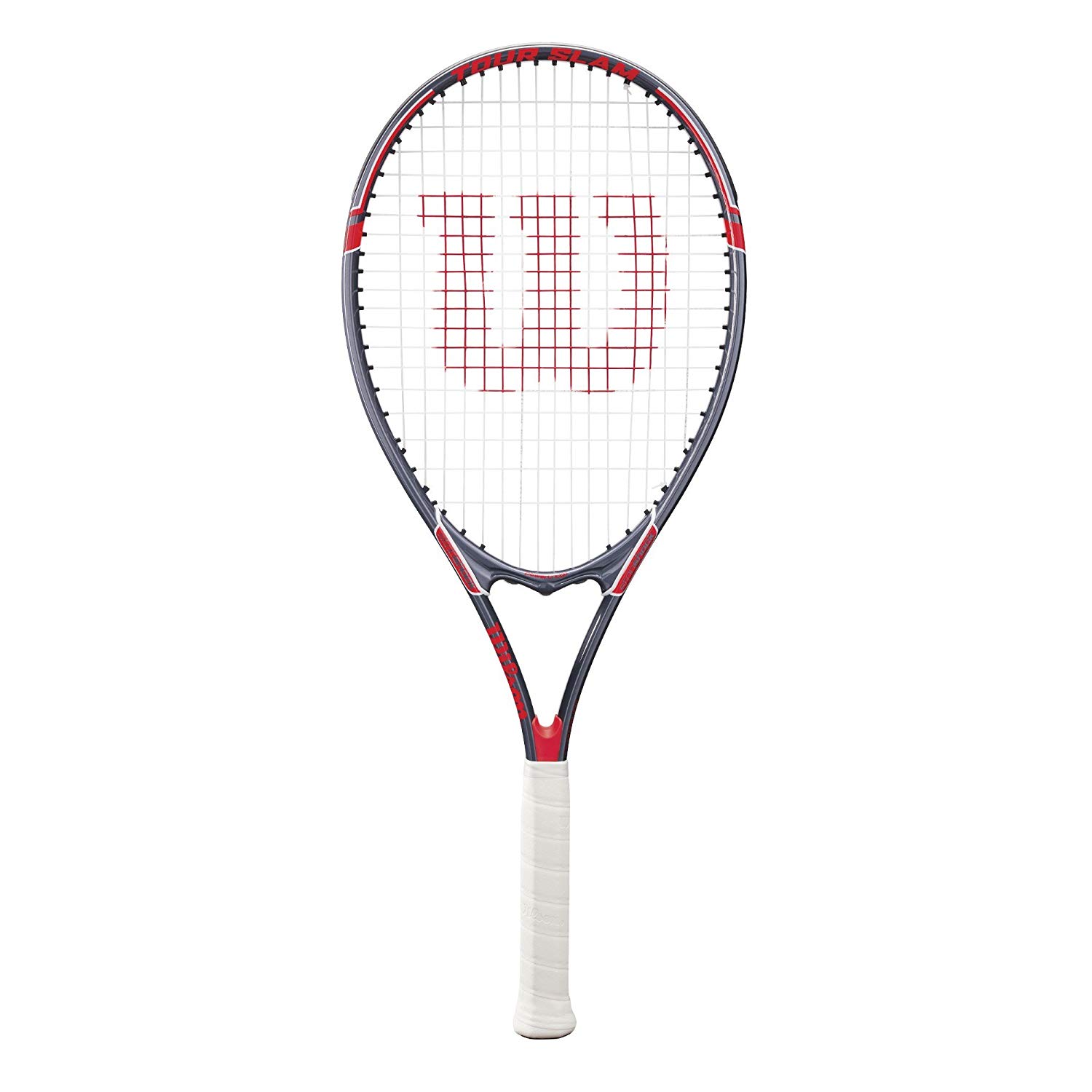
Editor’s Rating:
Composition
This is a wholly synthetic racquet with an aluminum body. It has a large head size of 112 square inches, which benefits beginners by providing an easy sweet spot. At 10.3 ounces, it isn’t the lightest racquet out there, so seniors and young children should seek a more lightweight option.
Volcanic Frame Technology
Volcanic frame technology has been implemented into the bridge of the racquet which adds power and stability to your shots. Coupled with the inclusion of Stop Shock Pads, the Wilson Tour Slam feels incredibly sturdy as it absorbs and returns shots. Even without implementing techniques that come with experience, beginners can get the sense of hitting the ball with great force.
Experience Level
Wilson’s Tour Slam will power you all the way through from beginner to intermediate level play. Its composition makes it an ideal fit for anyone looking to add an element of extra power to their game, or for those working on backhand technique. It’s also a good option for advanced players to keep in their arsenal if ever they need an extra racquet for recreational play. However, for the most part, advanced players will look for options more specific to their playstyle.
- Large sweet spot
- High quality construction
- Good mix of power and control
- White grip handle can get dirty
- Might be too heavy for certain players
2. Wilson Hyper Hammer
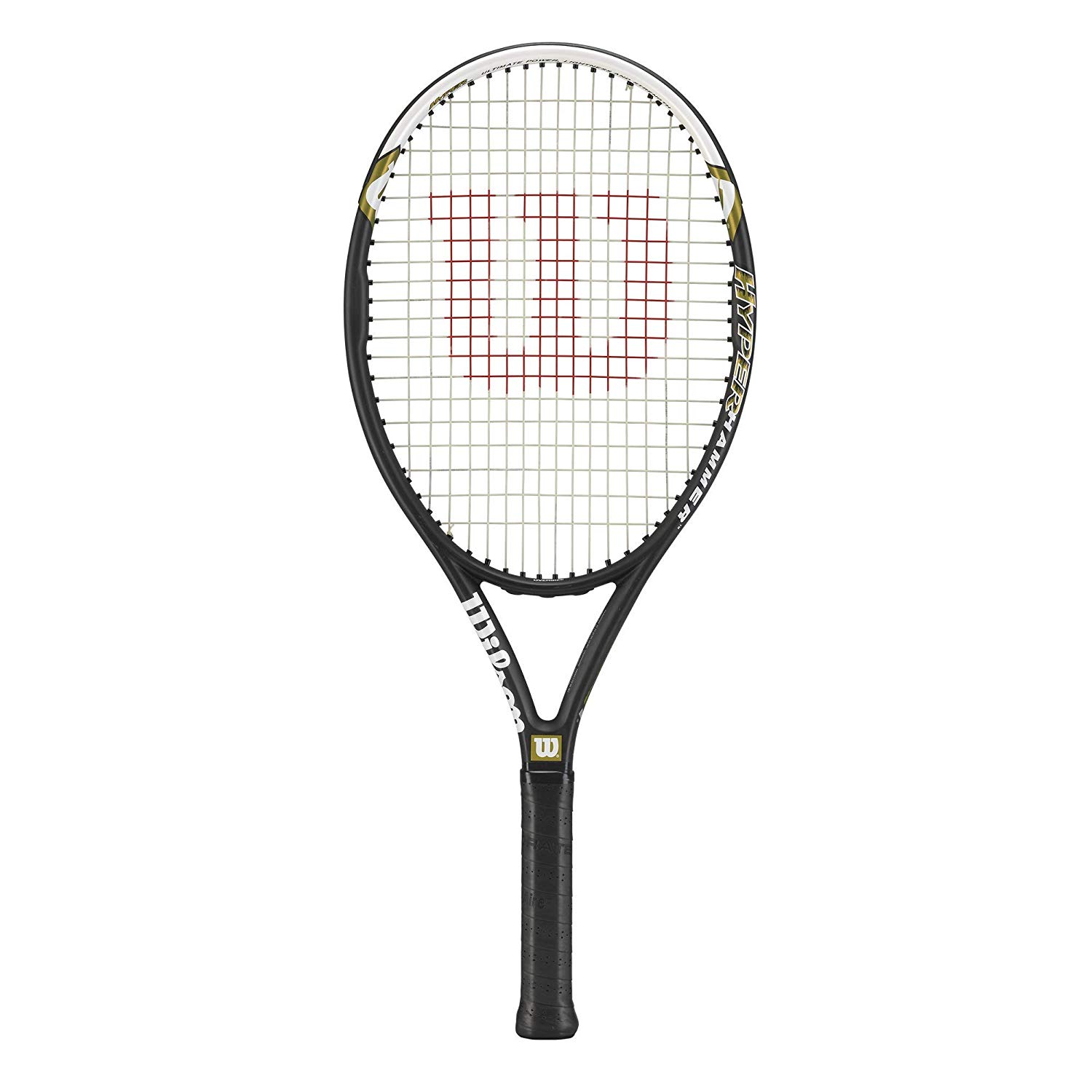
Editor’s Rating:
Composition
With a head size of 110 square inches, Wilson’s Hyper Hammer makes it easy to hit the sweet spot. The racquet’s weight is inclined toward the head, so you’ll be able to generate a considerable amount of power even when your shots are slightly off center. Its 16 x 20 open string pattern also helps with shot velocity. You’ll find an improved reach for your volleys and serves thanks to its 27.5 inch length.
Hyper Carbon Technology
The Hyper Carbon Technology used in forging the Wilson Hyper Hammer is known for its applications in the aerospace industry. In other words, there’s a bit of rocket science at play in the composition of this racquet. Hyper Carbon is 65% lighter than titanium while being 400% stronger and stiffer. This allows for fantastic control over exceptionally powerful shots.
Experience Level
This racquet is an ideal fit for recreational players of varying skill levels. Its highly forgiving composition makes it great for practicing groundstrokes, serves and volleys. If you’re a beginner, you’ll find that the increased access to power and control here can make up for a lack of experience — to an extent. The more you use it, the more accustomed you’ll be to its unique feel. Conversely, the Hyper Carbon Technology makes this one of the best intermediate tennis racquets as well. Overall, the amount of power Wilson’s Hyper Hammer can generate, coupled with its lightweight feel, makes it an attractive option for a range of players.
- Hyper Carbon Technology
- Head heavy frame provides great access to power
- Optimal length providing great reach
- Lightweight and easy to maneuver
- Power can be excessive when using full swings
- High vibration levels can be taxing on the body
3. Wilson Federer
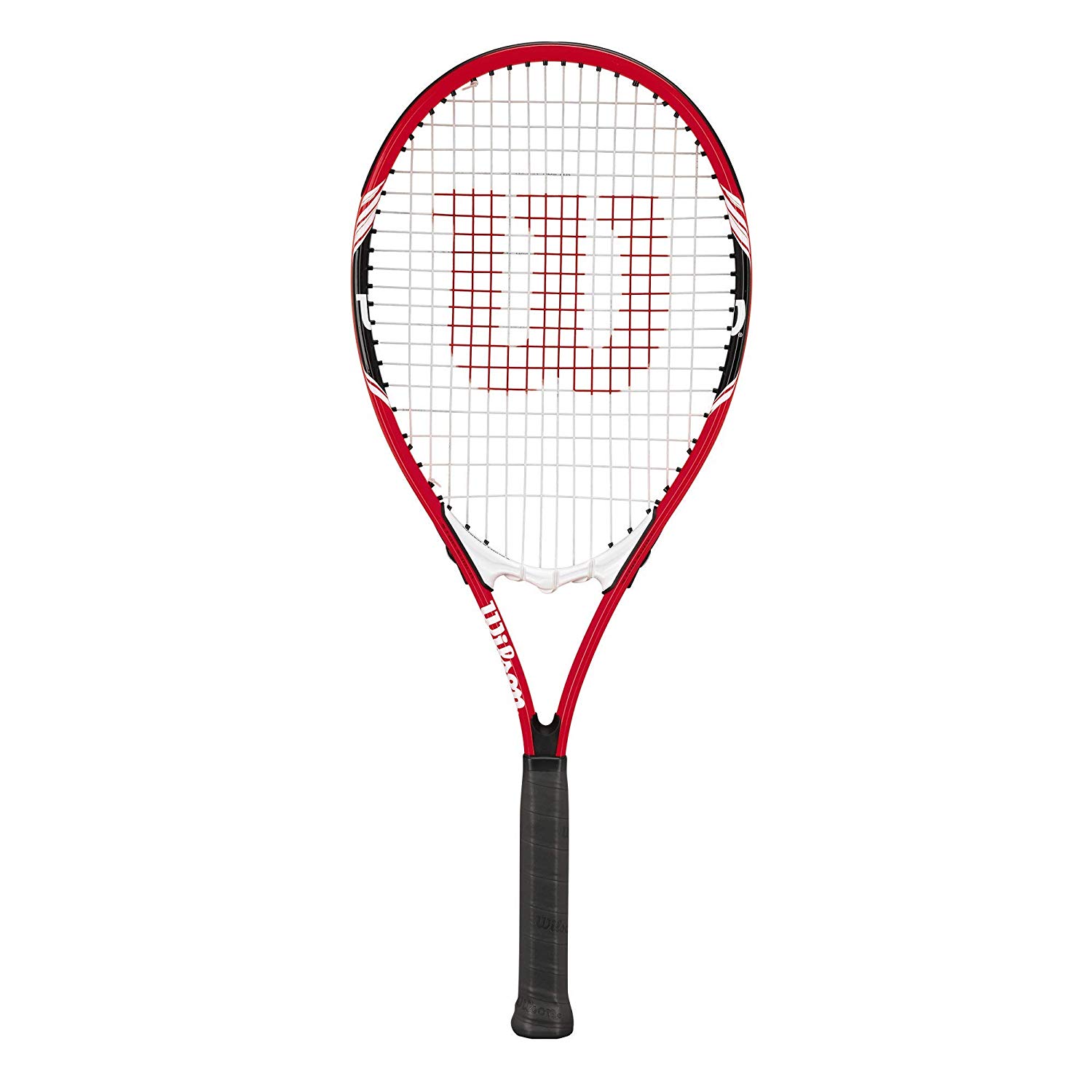
Editor’s Rating:
Composition
The Wilson Federer’s head size is 106 square inches with head-light balance, meaning there is more mass in the handle of the racket. The string pattern features an additional length in the main strings which allows for more power. Bound by AirLite Alloy construction, its 10.4 ounce strung weight makes it very easy to maneuver.
Other Features
For players who have trouble getting the right handle on their racquet, there’s a lot to love about this model’s perforated grips. Moisture wicking is embedded into the racquet’s handle, which helps with the age-old tennis issue of sweaty hands. Its shock pads go a long way in reducing vibration, which also helps players maintain a solid grip. Finally, the embedded Arc technology comes with a series of benefits that lead to a vastly increased sense of control.
Experience Level
While strict novices might experience a slight learning curve while using this racquet, it’s versatile enough to be used by most beginner and intermediate level players. With its great balance of comfort and durability, it’s likely to provide players with years of valuable practice before they’re ready to graduate to a more advanced level racquet.
- Great grip
- Sturdy, lightweight build
- Solid shock absorption
- Not many color choices
4. Babolat Pure Strike

Editor’s Rating:
Composition
The Babolat Pure Strike racquet has a 98 square inch head with a sweet spot that’s 10% bigger than similarly sized models. This provides an increased error margin for advanced players looking to implement power into their shots without risking inaccuracy. The 16×19 string pattern is ideal for generating shots with a ton of spin. With its graphite frame, the racquet is quite easy on the arm despite its power generating potential.
Woofer Dynamic String System
What sets this racquet apart from other models is the Woofer Dynamic String System implemented into its composition. This configuration allows the strings more freedom of motion within the boundaries of the frame. Essentially, this translates to a boost of power, since the freer strings create a trampoline effect as they absorb the shock of the impact and relay the shot. The effect is augmented by the low density string bed.
Experience Level
Babolat’s Pure Strike user base ranges from intermediate to advanced levels of play. The quality put into its production will be apparent to players of all skill levels. Aside from its average head size, it’s built to forgive intermediate players who need some work on their precision. It’s also perfectly suited to an experienced player with an aggressive style. The amount of control provided here allows complete manipulation over a ball’s spin and trajectory.
- Increased sweet spot gives greater access to power
- Stiff frame provides great control
- Lightweight composition allows for rapid swinging
- Might be too light for some players
5. Babolat Pure Aero
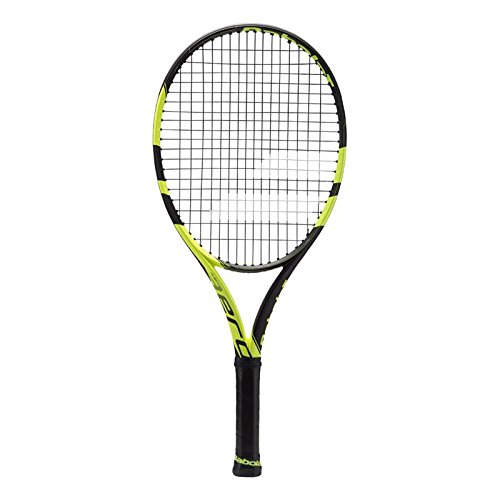
Editor’s Rating:
Composition
With a strung weight of 11.3 lbs, default string tension of 55 lbs and head size of 100 square inches, this is among the most user friendly racquets in the intermediate to advanced category. Despite that, its composition allows even the world’s elite players to get the amount of control they need during high level play. This is helped greatly by the grommet holes of 16 x 19 laid over a well-supported string bed.
Active Cortex Technology
Aside from building an overall solid racquet, Babolat made sure to add a bit of technological innovation into the mix. Their integration of Active Cortex Technology can be found in the racquet’s frame, right above the grip. This feature significantly reduces shock and vibration levels, allowing for greater levels of control. It will only take a few minutes of play for experienced athletes to feel the increased stability this racquet offers.
Experience Level
The Babolat Pure Aero definitely caters to the needs of high intermediate to advanced level players. With so many characteristics and so much potential embedded in the racquet, only a player with considerable experience can take advantage of it. Of course, even the most advanced racquets can be used in the hands of a beginner, so players of any level are free to give it a try. However, there are definitely some other options in this list specifically made for beginners.
- Great for intermediate to advanced level players
- Innovative construction
- Solid mix of comfort and control
- Requires the player to provide their own power
6. Head Microgel Radical
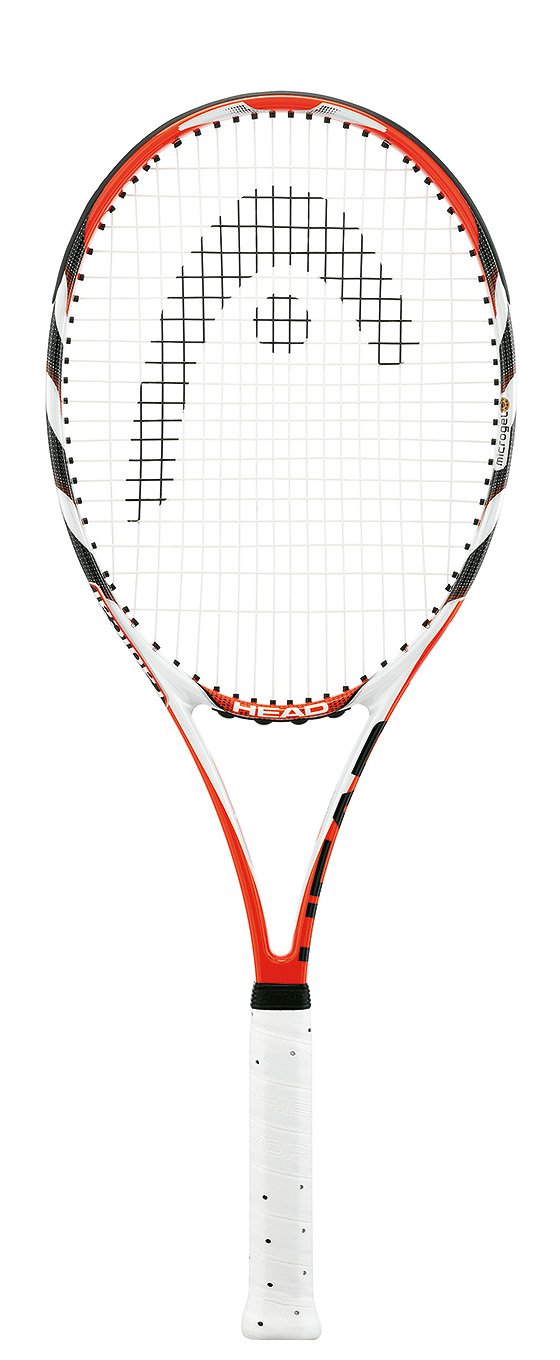
Editor’s Rating:
Composition
The Head Microgel Radical racquet features a 98 square inch head width that helps generate spin. It is good at generating long distance shots with higher bounces. Experienced players will appreciate the control granted by the racquet’s weight distribution — slightly lighter at the head than the handle. The overall design results in comfortable, stress-free play, allowing you to maintain an energetic style for longer periods of time.
MicroGel Technology
The MicroGel Technology used in the making of this racquet is one of its most attractive features. It allows for a great sense of support and comfort. As you make contact with the ball, you’ll feel the Head Microgel Radical absorbing its energy, compressing itself in order to properly return the shot. The ultimate result is comfortable gameplay that’s fully in your control. This effect is also due in part to the racquet’s stiff carbon fibers.
Experience Level
Head’s Microgel Radical racquet has definitely been produced with intermediate to advanced players in mind. While its composition is optimized for control and comfort, it isn’t forgiving for beginners still working on technique refinement. Advanced players, on the other hand, will love the versatility this racquet offers, and they’ll surely have fun experimenting with its capabilities. Intermediate players looking to advance their skill set will also enjoy learning with it.
- Great control over shot depth
- Even distribution of impact vibrations
- Increased width makes for great spins
- Small sweet spot
- Decreased power due to increased control
7. Oppum Carbon Fiber
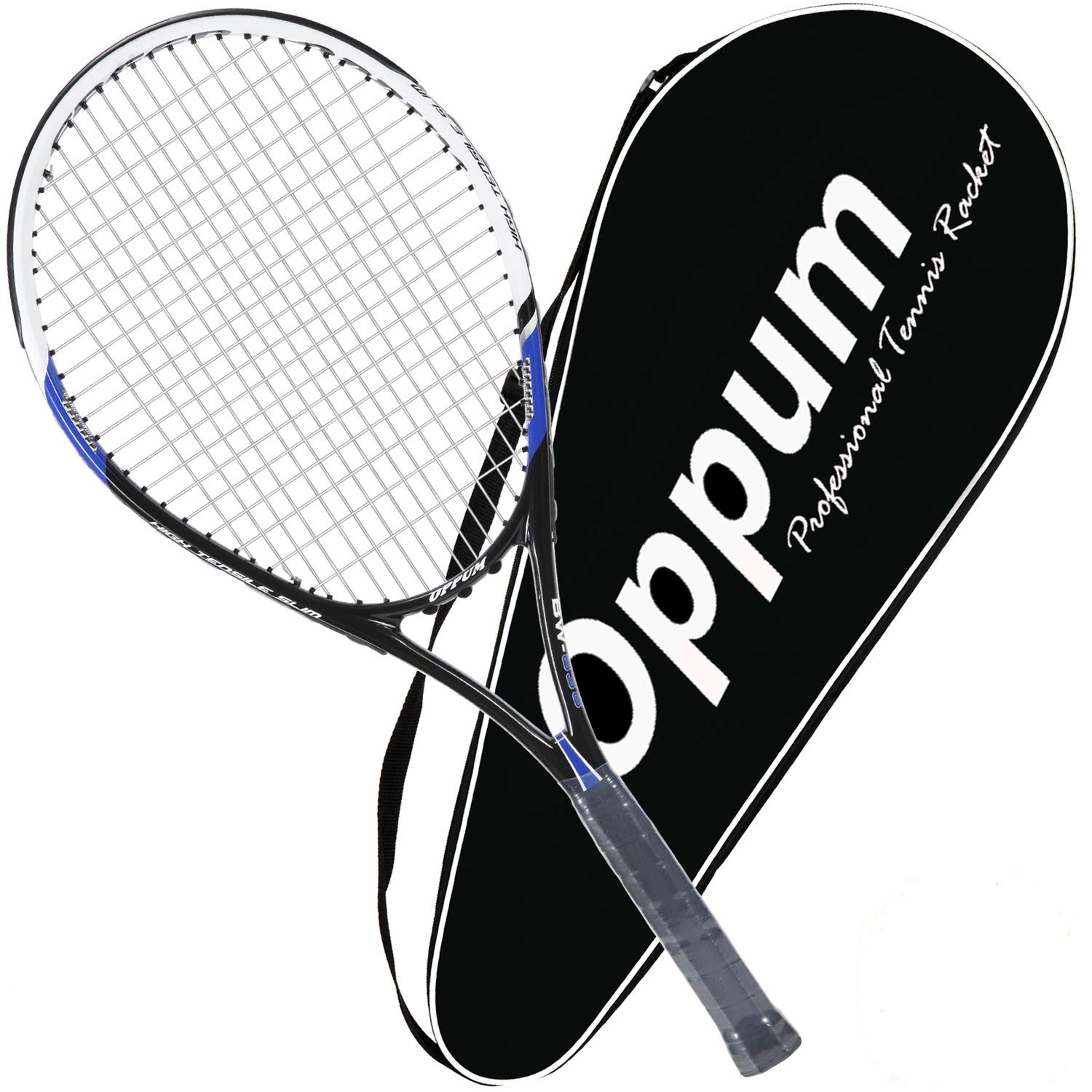
Editor’s Rating:
Composition
This racquet features a wide face with a broad sweet spot, which it forgiving for newer players. Even a relatively inexperienced player can achieve considerable accuracy, and they’ll enjoy a comfortable swing made possible by the racquet’s light weight. Thanks to the mix of aluminum and carbon fiber used in its composition, it feels sturdy and flexible.
Other Features
The racquet’s wooden handle is comfortable to hold and accommodates a 4 ⅜” grip size. Combined with its lightweight build, this makes for a comfortable playing experience. You can find yourself out on the court for a long while without having your arm give out on you. Considering the flexibility in style on offer here, its price point is quite attractive, especially for newcomers to the sport. On top of that, it also comes with a custom carrying bag.
Experience Level
If you’re a beginner looking for a cost-efficient racquet to help get you into the swing of the game, there’s a lot to love about Oppum’s Carbon Fiber option. With its broad sweet spot and low string vibration, you’ll have better control over your shots and an overall comfortable experience. It’s also a good option for intermediate players looking for a generally reliable racquet.
- Suitable for beginners and intermediate level players
- Lightweight
- Carrying bag included
- Lack of durability
- Requires regular restringing
8. Head Ti Conquest
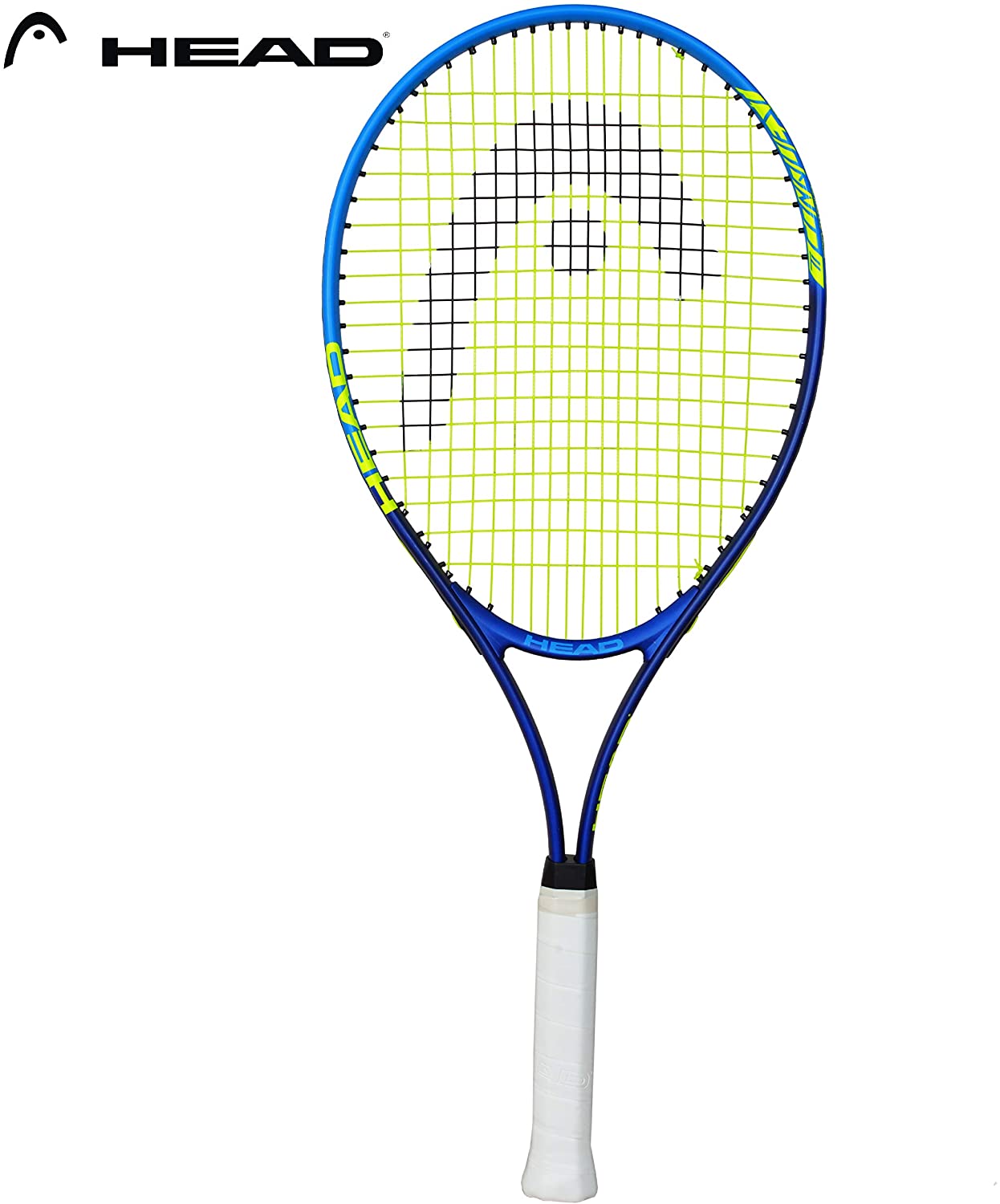
Editor’s Rating:
Composition
The Head Ti Conquest comes with a head size of 115 square inches and is slightly head heavy. This creates a low barrier of entry for novices looking to get into the game, as they’ll be free to start swinging from the get-go. With a weight of 8 oz, the racquet is a breeze to maneuver. It also comes in a great length for beginners — 27 ¾”. This feature will come in handy when you need that extra inch or two in order to properly hit a shot.
Other Features
The head of the racquet has been designed with Stop Shock technology. This, combined with its graphite and aluminum frame, makes for an incredibly stiff and sturdy feel. There’s a reduced sense of vibration upon impact, so players can play the game longer than they would with a poorer quality racquet without getting tired. The racquet’s light weight also factors into the improved sense of stamina players experience while using it.
Experience Level
While this is certainly an applicable option for intermediate players looking for a sturdy, easy to use racquet, Head have definitely aimed this one toward the beginner demographic. Simply put, it’s been produced in a way that allows total novices to get into the game without being restrained by the demands of their racquet.
- Comfortable length
- Oversized head
- Lightweight
- Not very durable
- Doesn’t offer much control
9. Wilson Blade Team
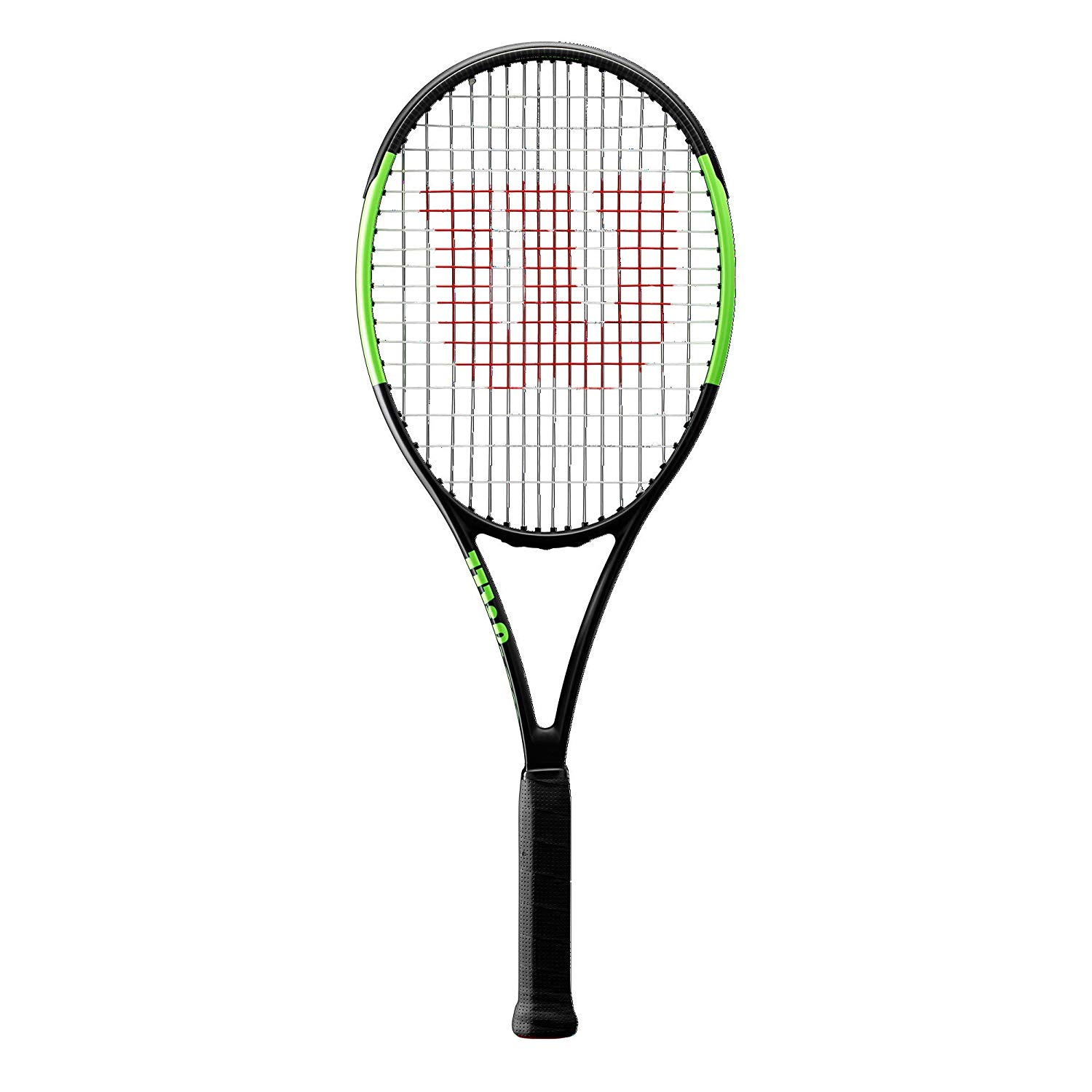
Editor’s Rating:
Composition
At 10.4 ounces and with a 99 square inch head size, the Wilson Blade Team’s composition offers solid playability with a very small learning curve. There are two available string configurations — the 18 x 20 pattern offers greater power generation while the 16 x 19 pattern provides better levels of control.
Countervail Construction
Wilson implemented Countervail technology into the construction of the Blade Team. Through this process, they’ve incorporated additional carbon fibers into the racquet’s frame in order to help its energy absorption while keeping it as light as possible. The Countervail implementation dampens the impact of incoming shots so that you can relay them with greater precision. Essentially, this translates to faster swing speeds and decreased levels of arm fatigue.
Experience Level
The Wilson Blade Team is an exemplary racquet for intermediate players. While it’s not so forgiving as to hold the player’s hand as they learn, the performance is user friendly enough to allow players to focus less on the demands of the racquet and more on the development of their technique. In fact, its low barrier of entry makes it a fitting option for a beginner with a small degree of experience, though they’ll have to put in the work to get the most out of this racquet.
- Solid Countervail construction
- Great control
- Easy to execute fast swings
- Decreased power in favor of control
- Not optimized for serving
10. Wilson [K] Zero
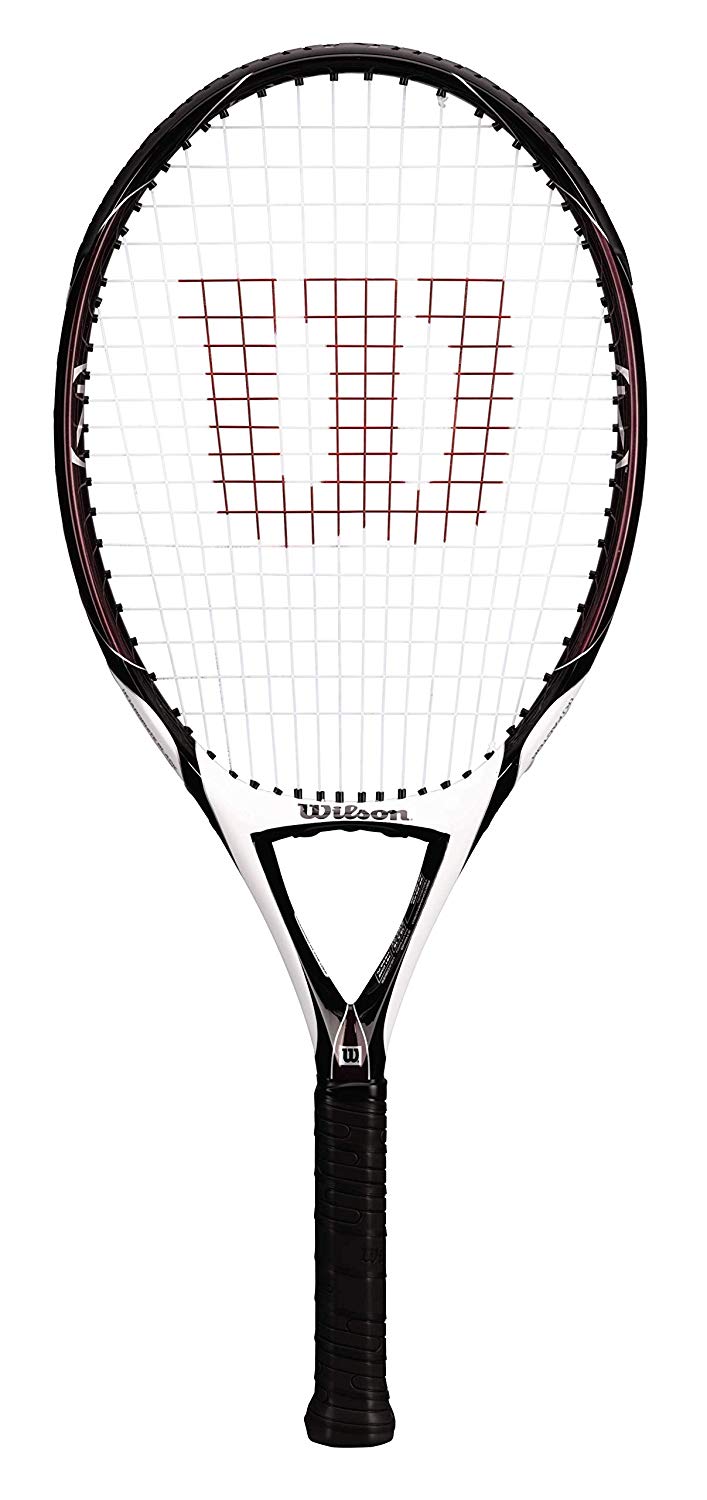
Editor’s Rating:
Composition
The Wilson [K] zero is made to generate considerable amounts of power. Its pre-strung tension is 60 lbs. The 118 square inch head allows you to relay explosive shots without demanding perfect precision. This makes it a good fit for beginners as well as intermediate players. In experienced, precise hands, the racquet provides a blank canvas for some seriously high velocity.
Other Features
At 9.1 oz, this is the lightest K factor racquet offered by Wilson, which makes its potential for generating power all the more accessible. Grip sizes range from 4 1/4″ through 4 1/2″. Its balance is head heavy, prioritizing power over control. As an added bonus, the kit also comes with a protective cover.
Experience Level
The oversized head makes the Wilson [K] Zero highly forgiving. Beginners can take it to the tennis court and get into the mix of the game without missing a step. Intermediate players will find it quite pleasant to use, and they’ll definitely enjoy the easy, direct access to power. Although more professional level players can certainly make use of this racquet, they’re generally better off looking for one that offers more control and adaptability.
- Solid overall feel
- Large head size
- Good fit for beginners
- Lack of control
- Vibrations are quite strong
Guide to Buying the Best Tennis Racquets
Whether you’re just getting into the game of tennis, or you’re an intermediate to advanced level player looking to supplement your knowledge of racquets, our buyer’s guide has you covered.
The big manufacturers in this sphere tend to make their racquets stand out by implementing unique technologies and specific features. While these are welcome additions, they do tend to make the shopping phase a little confusing. Trudging through the vast library of options to find the right racquet can be a difficult task. In the end, it’s all about choosing the best option for your needs while keeping the following fundamentals in mind.
Types of Racquets
Let’s begin by separating tennis racquets into their own specific categories. We can split them into four divisions.
Tweener Racquets
Tweener Racquets generally contain a mix of favorable attributes from other categories. They offer a combination of power and control. As such, they’re among the most popular types of racquet sold today.
Typical tweener racquets are light to medium weight, feature medium to above average head size and their balance ranges from head-light to head-heavy. They have good power potential, being capable of expelling dynamic shots in the hands of an experienced player. They’re also ideal for producing spins.
Power Racquets
As the name implies, power racquets tend to place their emphasis on generating power. Generally, power racquets come with very large heads and a great body length. Their orientation is either head heavy or evenly balanced in order to maintain leverage toward the ball being hit. These are typically lightweight racquets, weighing in at less than 10 ounces. They’re an ideal fit for players with short swings looking for a boost in power.
Traditional Racquets
Traditional racquets are categorized by their use among the elite players of the game, from college to professional levels. They feature a small head size with sparser beams. The balance is head light and the weight is quite heavy, exceeding 12 ounces in some cases. Ultimately, this results in a racquet that isn’t capable of producing much power on its own. Instead, it relies on an experienced hand to provide the power while offering its handler complete control.
Modern Racquets
As high-level tennis evolved over the years to favor heavy top-spins, the modern racquet was born. They’re lighter than traditional racquets, thus enabling faster play. Their head sizes are also slightly larger, providing a boost in power. If you’re an aggressive player looking to access a variety of angles in order to achieve consistent spin, then a modern racquet might be the right fit for you.
Body Length
Tennis racquets vary in length anywhere between 26 to 29 inches. The standard measurement is around the 27 inch mark.
Because longer racquets require a greater swing weight, some extra effort is needed in order to achieve proper control over gameplay. On the other hand, racquets with greater length offer improved access to groundstrokes and a slight boost in power. Although the difference is relatively small, beginners will have an easier time with their learning experience by opting for a racquet with a long body.
Head Size
Here’s how tennis racquets’ head sizes break down: Midsize (85 – 96 square inches); Midplus (96 – 106 square inches); Oversize (107 – 115 square inches); Super Oversize (116 square inches or more).
While Roger Federer will likely hit a more powerful shot than we ever can regardless of the type of racquet we’re using, power levels depend directly on a racquet’s head size. The larger the head, the more powerful the shot potential. Furthermore, when a racquet has a large head, it also comes with an increased sweet spot area. This makes it much more forgiving when hits aren’t positioned quite so precisely.
Racquets are offered in a general head size range of 85 to 135 square inches. We can consider the middle range being 100 square inches — this provides the combination of control and power sought by the typical intermediate player.
Racquets with larger head sizes offer a good learning experience to beginners, since the increased sweet spot range makes up for the lack of technique. Meanwhile, advanced players tend to prefer smaller head sizes as this grants them much more control over their gameplay.
Balance and Weight
The specific “feel” that comes with picking up a racquet for the first time can be attributed to its balance and weight.
Balance
A racquet’s balance can be categorized as being either head-heavy (HH), head-light (HL) or even-balance (EB).
A head-heavy racquet emphasizes its mass on the head, which helps in hitting powerful shots. When a racquet is head-light, its body is typically heavier than average, allowing advanced level players to exhibit greater control over their output. Finally, even balanced racquets offer a combination of power and control.
Weight
Broadly speaking, the heavier the racquet is, the more power it’s capable of generating. Heavy racquets also convey less shock upon impact when compared to a light racquet. The overall experience from using a heavy racquet is that the extra weight helps the user in following through with their shots.
Meanwhile, a light racquet offers greater maneuverability, making them by far the more popular pick at the elite level. Players with years of experience can create power from their technique, so they tend to prefer racquets that provide greater elements of control. Light racquets allow players to produce a faster swing, which can generate a great amount of spin. They’re also key during quick at-the-net exchanges that require the player to swing with a dynamic range of motion.
It’s worth noting that there are methods which allow you to increase the weight of a lighter racquet. On the other hand, no sound method has been discovered for reducing the weight of a heavy racquet.
Frame Stiffness
While it all depends on the construction of the racquet in question, as a general rule of thumb: the stiffer the racquet is, the less comfortable it will be to maneuver. This is because racquets with stiff frames will relay stronger vibrations from the impact of the ball hitting the head to the wrist, then down to the arm.
Because stiff racquets don’t bend as much, they absorb less energy from the ball upon impact. Meanwhile, the increased bend in the frame of a flexible racquet will result in increased energy loss.
Beginners and intermediate level players tend to gravitate toward stiff racquets since they offer a nice mix of power and control. Meanwhile, advanced players generally tend to prefer flexible racquets, since they supply their own power.
That said, there’s a vast amount of configurations that advanced players experiment with. For instance, an expert tennis player might choose a stiff frame used in tandem with a stiff string configuration. Although relatively uncomfortable, this setup allows the player great access to both power and spin.
String Pattern
The two main string patterns found in tennis racquets are either open (using less strings and featuring larger gaps) or closed (using more strings and featuring smaller gaps). While casual players don’t tend to pay much attention to string pattern, it’s an essential attribute of a racquet that has a big say in its performance.
Open string patterns offer more of a trampoline effect than closed string patterns. They recoil on impact in order to provide a more significant rebound. While it’s difficult to categorize string pattern types based on experience level, beginners using open patterns will have easier access to more powerful shots from tighter angles. Depending on the specific string configuration, certain open patterns will provide greater spin. This is due to the manner in which the main strings snap back into place. One downside to open string patterns is that they aren’t quite as durable as their closed counterparts. Because of the increased string movement, wear and tear is more of a factor.
Closed string patterns offer a noticeably tighter feel. Because they don’t recoil as much on impact, there’s less power being transmitted into the rebound. Returning to the point on control being prioritized over power at the top level of play, closed string racquets are the preferred choice among many elite players. However, the choice varies widely depending on the player in question, as it’s possible to find open string racquets configured to offer greater maneuverability.
Swingweight
As its name implies, swingweight refers to the density a racquet exhibits during its swing. When a racquet has a low swingweight, it doesn’t offer much comfort or stability, although it’s relatively easy to swing. Meanwhile, when a racquet has a high swingweight, it offers a great level of power, comfort and stability, although there’s more difficulty in executing the swing.
Beginners and intermediate level players tend to prefer racquets with low swingweight. This let’s them play faster, allowing them to focus on precision. On the other hand, experts largely gravitate toward high swingweight racquets, since they offer great access to power and the option to relay the energy absorbed from heavy incoming shots.
Wrapping Up
We hope this guide has given you a comprehensive overview of what to look for in a tennis racquet so you can find the one that’s right for you. In our reviews we’ve noted what experience level each racquet is broadly good for so you can be comfortable you’re getting something suitable. That said, even a beginner can use the most advanced racquet, so choose one that you think will suit you based on the things we’ve gone through in our buyer’s guide. All of the racquet’s on the list are from top brands that have a long history in making tennis racquets for the world’s best, so you can be sure that by buying one of these racquets you are getting the right tools to perhaps one day join them on center court.
